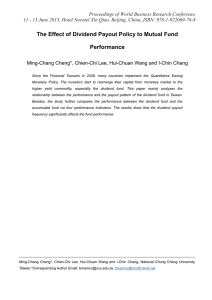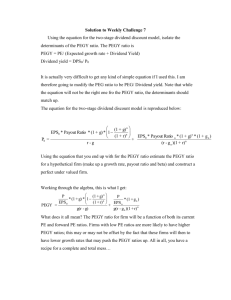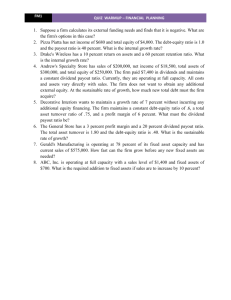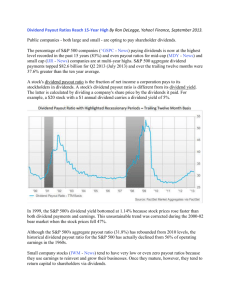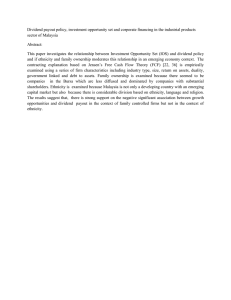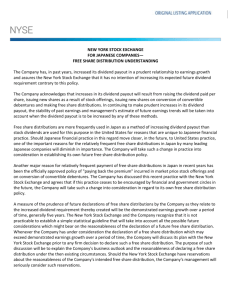Dividend Policy and Dividend Payment Behavior: Theory and Evidence
advertisement
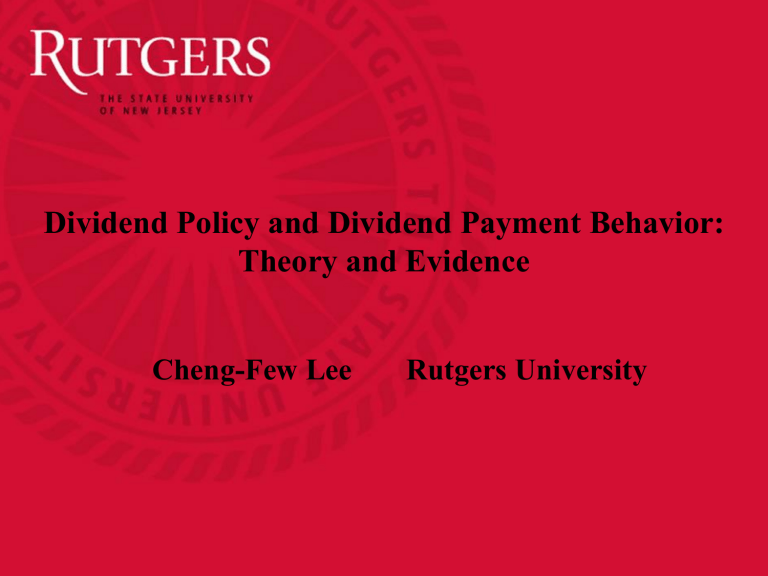
Dividend Policy and Dividend Payment Behavior: Theory and Evidence Cheng-Few Lee Rutgers University Announcement for Handbook of Financial Econometrics and Statistics • The purpose of this handbook is to publish original papers that apply either econometrics or statistics methods in important topics of empirical finance research. Chapters that update or expand upon well-known empirical papers are also acceptable. In this handbook, each paper should have appendices of 5 to 15 pages to demonstrate how empirical research has been executed. The tentative outline of this handbook is as follows: • Part I. Introduction In this introduction, we will discuss overall application of econometrics and statistics in finance accounting research. 2 • Part II. Overview of Financial Econometrics and Statistics A. Financial Econometrics B. Financial Statistics • Part III. Financial Econometrics A. Asset Pricing Research B. Corporate Finance Research C. Financial Institution Research D. Investment and Portfolio Research E. Option Pricing Research F. Future and Hedging Research G. New Financial Products Research H. Mutual Fund Research I. Financial Accounting Research 3 • Part IV. Financial Statistics A. Asset Pricing Research B. Investment and Portfolio Research C. Credit Risk Management Research D. Market Risk Research E. Operation Risk Research F. Option Pricing Research G. Mutual Fund Research H. Value at Risk Research • We expect to include approximately 100 chapters in this handbook, which will published online and in three print volumes by Springer in 2012. Anybody who wishes to contribute a chapter to this handbook please send a proposal to Professor Cheng-Few Lee at the email: lee@business.rutgers.edu 4 Flow Chart of Dividend Policy and Dividend Behavior Dividend Policy Time-Series Dividend Behavior Partial Adjustment Process Dividend Relevance Theory with Tax Effect Dividend Relevance Theory without Tax Effect Dividend Irrelevance Theory Information Content or Adaptive Expectations Cross-Sectional Signaling Hypothesis Myopic Dividend Policy CAPM Approach Free Cash Flow Hypothesis Flexibility Hypothesis Non-CAPM Approach Life-Cycle Theory Residual Dividend Policy 5 Empirical Analyses in Dividend Policy Research Descriptive Data Analysis Time Series Cross-Sectional Regression Analysis Time Series Probit / Logit Cross-Sectional Fama-MacBeth Procedure Panel Data Analysis Seemly Uncorrelated Regression (SUR) Fixed Effect Model 6 Dividend Policy and Dividend Payment Behavior A. Theory (i) Dividend irrelevance (M&M, 1961) and corner solution (DeAngelo and DeAngelo, 2006) (ii)Dividend relevance (Gordon, 1962; and Lintner, 1964) - A bird in hand theory (Bhatacharya, 1979) - Signaling theory (John & Williams, 1985; Miller & Rock, 1985; and Lee et al., 1993) - Free cash flow theory (Eastbrook,1984; Jensen, 1986; and Lang and Lizenberger,1989) - Financial flexibility theory (Jagannathan et al. 2000, DeAngelo and DeAngelo, 2006; Blau and Fuller, 2008) - Life-cycle theory (DeAngelo et al., 2006) 7 Dividend Policy and Dividend Payment Behavior B. Dividend Behavior Models (i) Partial Adjustment Model (Lintner, 1956 AER) Dt a0 a1 Dt 1 a2 Et et (1) (ii) Mixed Partial Adjustment and Adapted Expectation (Fama & Babiak, 1968 JASA) (iii) Generalized Dividend Forecasting Model (Lee et al., 1987, Journal of Econometrics) Dt a1 a2 Dt 1 a3 Dt 2 a4 Et vt (2) where a1 , a2 2 , a3 1 1 , a4 r , and vt ut 1 ut 1. 8 Dividend Policy and Dividend Payment Behavior C. Cross-Section Relationship between Stock Prices, Dividends, and Retained Earnings (i) Friend and Puckett (1964 AER) have proposed the relationship between stock prices, dividends, and retained earnings as follows: Pti A BDti CRti i 1, ,N t 1, ,T (3) where Pti , Dti , and Rti represtne price per share, dividend per share and retained earnings per share, respectively. Based upon Eq. (1) and discount cash flow model in terms of optimal forecasting, Granger (1975 JF) has shown that B and C can be written in terms of discount rate, ,a1and aof Eq. (1). Therefore, it can be concluded 2 that Eq. (3) is a theoretical derived model instead of an ad-hoc model. 9 Dividend Policy and Dividend Payment Behavior D. Integration of Dividend Policy and CAPM (Litzenberger and Ramaswamy 1982 JF) 10 Summary of Our Research 1. We propose a dynamic framework and show the existence of an optimal payout ratio under a perfect market. 2. The relationship between firm’s optimal payout ratio and its growth rate is negative in general. 3. The relationship between firm’s optimal payout ratio and its risks. - depends on its growth rate relative to its ROA - separate the considerations of free cash flow problem and flexibility 4. We develop a fully dynamic model for determining the time optimal growth and dividend policy under stochastic conditions. - A convergence process in the optimal growth rate. 5. Empirical evidence on the optimal payout ratio. (Supports our model) 11 Outline 1. Introduction 2. The Model for Optimal Dividend Policy 3. Comparative Static Analysis of Dividend Payout Policy 3.1 Case I: Total Risk 3.2 Case II: Systematic Risk 3.3 Total Risk and Systematic Risk 3.4 No Change in Risk 3.5 Relationship between the Optimal Payout Ratio and the Growth Rate 4. Joint Optimization of Growth Rate and Payout Ratio 4.1 Optimal Growth Rate v.s. Time Horizon 4.2 Optimal Growth Rate v.s. Degree of Market Perfection 4.3 Optimal Growth Rate v.s. ROE 4.4 Optimal Growth Rate v.s. Initial Growth Rate 4.5 Optimal Dividend Policy v.s. Optimal Growth Rate 12 Outline 5. Dividend Behavior Model 5.1 Partial Adjustment Model (Lintner, 1956 AER) 5.2 Mixed Partial Adjustment and Adapted Expectation (Fama & Babiak, 1968 JASA) 5.3 Generalized Dividend Forecasting Model (Lee et al., 1987, Journal of Econometrics) 6. Empirical Evidence 6.1 Sample Description 6.2 Multivariate Analysis 6.3 Fama-MacBeth Analysis 6.4 Fixed Effect Analysis 7. Summary and Concluding Remarks 7.1 Limitations of cross-sectional approach to investigate dividend policy 7.2 We need to use dividend behavior model to supplement cross-sectional approach to obtain more meaningful conclusion for decision making. 13 Introduction Dividend Policy Miller and Modigliani (1961) - Firm Value is independent of dividend policy. - Assumptions of M&M theory 1) no tax. 2) no capital market frictions (i.e., no transaction cost, asset trade restriction, or bankruptcy cost) 3) firms and investors can borrow or lend at the same rate. 4) firm financial policy reveals no information. 5) only consider no payout and payout all cash flow. DeAngelo and DeAngelo (2006) > M&M (1961) irrelevance result is “irrelevant” because it only considers payout policies that pay out all free cash flow. > Payout policy matters when partial payouts are allowed. 14 Introduction • • • Signaling Hypothesis - The signaling hypothesis suggests managers with better information than the market will signal this private information using dividends. - A company announcements of an increase in dividend payouts act as an indicator of the firm possessing strong future prospects. [Bhatacharya (1979), John and Williams (1985), Miller and Rock (1985), and Nissam and Ziv (2001)] Free Cash Flow Hypothesis (Agency Cost) - Dividend payment can reduce potential agency problem. [Eastbrook (1984), Jensen (1986), Lang and Lizenberger(1989), Lie (2000), and Grullon et al. (2002)] Financial Flexibility - Management trades off two aspects of Dividends. One is financial flexibility by not paying dividends. Another is deterioration on stock price if not paying dividends. 15 [Blau and Fuller (2008)] Introduction 1. Based on the DeAngelo & DeAngelo (2006) static analysis, we derive a theoratical dynamic model and show that there exists an optimal payout ratio under perfect market. 2. We derive the relationship between firm’s optimal payout ratio and its risks. 3. We derive the relationship between firm’s optimal payout ratio and its growth. 4. We further develop a fully dynamic model for determining the time optimal growth and dividend policy under the imperfect market, the uncertainty of the investment, and the dynamic growth rate. 5. We study the effects of the time-varying horizons, the degree of market perfection, and stochastic initial conditions in determining an optimal growth and dividend policy for the firm. 6. When the stochastic growth rate is introduced, the expected return may suffer a model specification. 7. Empirical evidence of the determination of the optimal payout policy. 16 The Model for Optimal Dividend Policy - Let r (t ) represent the initial assets of the firm and h(t ) represent the growth rate. Then, the earnings of this firm are given by Eq. (1), which is x(t ) r (t ) A(o)eht (1) - The retained earnings of the firm, y t , can be expressed as y (t ) x(t ) m(t )d (t ) (2) where m(t ) is the number of shares outstanding, and d (t ) is dividend per share at time t. 17 The Model for Optimal Dividend Policy The new equity raised by the firm at time t can be defined as e(t ) p(t )m(t ) (3) where = degree of market perfection, 0 < 1. Therefore, the investment in period t can be written as: hA(o)eht x(t ) m(t )d (t ) m(t ) p(t ) (4) Rearranging Eq.(4), we can get d (t ) r (t ) h A(o)e ht m(t ) p(t ) m(t ) (5) 18 The Model for Optimal Dividend Policy - The stock price should equal the present value of this certainty equivalent dividend stream discounted at the cost of capital (k) of the firm. p(o) dˆ (t )e kt dt T 0 ( A bI h) A(o)eth m(t ) p(t ) A(o) 2 (t ) 2 (t ) 2 e 2th kt [ ]e dt 2 0 m(t ) m(t ) T (14) - Eq.(14) can be formulated a differential Equation: m(t ) p(t ) [ k ] p(t ) G(t ) (17) m(t ) (a bI h) A(o)eth A(o)2 (t )2 (t ) 2 e2th where G(t ) m(t ) m(t )2 (18) 19 Optimal Dividend Policy Optimal Payout Ratio when 1: D(t ) (a bI h) (h (t ) 2 (t ) 2 (t ) 2 (t ) 2 (t ) 2 (t ) 2 )[e( h k )(T t ) 1] 1 x (t ) (a bI ) (t ) 2 (t ) 2 (h k ) (a bI h) [e( h k )(T t ) 1] (t ) 2 (t ) 2 = 1 h 2 (a bI ) (h k ) (t ) (t ) 2 (26) 20 Relationship between the Optimal Payout Ratio and the Growth Rate [ D(t ) / x (t )] h k h h k (T t ) e( h k )(T t ) k 1 k he( h k )(T t ) h ( )[ ] (1 ) 2 a bI hk a bI h k (32) - The sign is not only affected by the growth rate (h), but is also affected by the expected rate of return on assets (a bI ), the duration of future dividend payments (T-t), and the cost of capital (k). - Sensitivity analysis shows that the relationship between the optimal payout ratio and the growth rate is generally negative. =>a firm with a higher rate of return on assets tends to payout less when its growth opportunities increase. 21 22 Relationship between the Optimal Payout Ratio and the Growth Rate [ D(t ) / x (t )] (a bI ) h (T t ) h(T t ) 1 h a bI (34) 1 1 When h (a bI ) , there is a negative 2 (T t ) relationship between the optimal payout ratio and the growth rate. =>when a firm with a high growth rate or a low rate of return on assets faces a growth opportunity, it will decrease its dividend payout to generate more cash to meet such a new investment. 23 Implications Hypothesis 1: firms generally reduce their dividend payouts when their growth rates increase. The negative relationship between the payout ratio and the growth ratio in our theoretical model implies that high growth firms need to reduce the payout ratio and retain more earnings to build up “precautionary reserves,” while low growth firms are likely to be more mature and already build up their reserves for flexibility concerns. [Rozeff (1982), Fama and French (2001), Blau and Fuller (2008), etc.] 24 Optimal Payout Ratio vs. Total Risk D(t ) / x (t ) (t ) 2 ( t ) 2 h (1 a bI e( h k )(T t ) 1 ) h k (27) High growth firms h a bI : negative relationship between optimal payout ratio and total risk. Low growth firms h a bI : positive relationship between optimal payout ratio and total risk 25 Optimal Payout Ratio vs. Systematic Risk D(t ) / x (t ) (t ) 2 ( t ) 2 h (1 a bI e( h k )(T t ) 1 ) h k (28) High growth firms h a bI : negative relationship between optimal payout ratio and systematic risk. Low growth firms h a bI : positive relationship between optimal payout ratio and systematic risk 26 Implications • Hypothesis 2: the relationship between the firms’ dividend payouts and their risks is negative when their growth rates are higher than their rates of return on asset. - Flexibility Hypothesis High growth firms need to reduce the payout ratio and retain more earnings to build up “precautionary reserves.” These reserves become more important for a firm with volatile earnings over time. => For flexibility concerns, high growth firms tend to retain more earnings when they face higher risk. 27 Implications • Hypothesis 3: the relationship between the firms’ dividend payouts and their risks is positive when their growth rates are lower than their rates of return on asset. - Free Cash Flow Hypothesis 1. Low growth firms are likely to be more mature and most likely already built such reserves over time. 2. They probably do not need more earnings to maintain their low growth perspective and can afford to increase the payout [see Grullon et al. (2002)]. 3. The higher risk may involve higher cost of capital and make free cash flow problem worse for low growth firms. => For free cash flow concerns, low growth firms tend to pay more dividends when they face higher risk 28 Optimal Payout Ratio vs. Total Risk and Systematic Risk (t )2 (t )2 d [ D(t ) / x (t )] d ( ) d( ) 2 2 (t ) (t ) where (29) h e ( hk )(T t ) 1 (1 )[ ] a bI hk • Relative effect on the optimal dividend payout ratio (t )2 (t )2 d[ ] d [ ] 2 2 (t ) (t ) (30) 29 Optimal Payout Ratio when No Change in Risk h k he( h k )(T t ) [ D(t ) / x (t )] (1 )[ ] a bI hk (30) When there is no change in risk, the optimal payout ratio is identical to the optimal payout ratio of Wallingford (1972). 30 Joint Optimization of Growth Rate and Payout Ratio • The new investment at time t is dA t A t dt t g s ds o g t A o e (3) Y t D t n t p(t ) LA t Retained Earnings New Equity where New Debt D t the total dollar dividend at time t; p t price per share at time t; degree of market perfections, 0 < l; n t P t the proceeds of new equity issued at time t; L = the debt to total assets ratio 31 Joint Optimization of Growth Rate and Payout Ratio • The model defined in the equation (3) is for the convenience purpose. If we want the company’s leverage ratio unchanged after the expansion of assets then we need to modify equation (3) as t g s ds o A t g t A o e Y t D t n t p(t ) 1 D / E Y t D t n t p (t ) we can obtain the growth rate as g (t ) Our Model ROE 1 d 1 ROE 1 d n t p t / E 1 ROE 1 d Higgins’ sustainable g which is the generalized version of Higgins’ (1977) sustainable growth rate model. Our model shows that Higgins’ (1997) sustainable growth rate is under-estimated due to the omission of the source of the growth related to new equity issue which is the second term of our model. 32 Joint Optimization of Growth Rate and Payout Ratio Discount cash flow p o dˆ t e kt dt T (8) 0 The price per share can be expressed as PV of future dividends with a risk adjustment. p o 1 n o T 0 g s ds 1 2 2 2 0 g s ds kt 2 0 r t g t A o e a A o t n t e n t e dt Future Dividends t t Risk Adj. => maximize p(o) by jointly determine g(t) and n(t). 33 Optimal Growth Rate g t * r r rt 2 1 1 e go go r go r go e (19) rt 2 Logistic Equation – Verhulst (1845) => a convergence process 34 Case I: Optimal Growth Rate v.s. Time Horizon r r r t 2 r 1 e * g t go 2 * g t 2 t r r t 2 1 1 e go (20) When g0 r , g* t 0. When g0 r , g* t 0. When g0 r , g* t 0. 35 Case I: Optimal Growth Rate v.s. Time Horizon Convergence Process - Firms with different initial growth rates all tend to converge to their target rates (ROE). 36 Case II: Optimal Growth Rate v.s. Degree of Market Perfection g * t r r t 2 2rt 1 e 2 g 2 o r r t 2 1 1 e go 2 (21) If the market is more perfect is larger , the speed of convergence is faster. 37 Case II: Optimal Growth Rate v.s. Degree of Market Perfection 38 Case III: Optimal Growth Rate v.s. ROE g * t r t rt 2 rt 2 go go 1 e g o r re 2 go r go e rt 2 2 (22) When initial growth rate is lower than the target rate (ROE), eq. (22) is positive. => If the target rate (ROE) is higher, the adjustment process will be faster. 39 Case IV: Optimal Growth Rate v.s. Initial Growth Rate 2 g * t g o r rt 2 e go r rt 2 1 1 e g o 2 (23) Eq. (23) is always positive. => The higher initial growth rate is, the higher optimal growth rate at each time. 40 41 Optimal Dividend Payout Ratio D t g* t 1 Y t r t 2 * * 2 * t 2 kt g * s ds t t g t r g t t g t 0 1 e W 3 2 * 2 t r g t T where W t s (29) 2 g u du ks 2 1 e 0 s r g * s ds * • Assuming 1 and g * t g * , ( g * k )(T t ) 2 e 1 D t g ( t ) * 1 1 g Y t r t (g* k ) (t ) 2 * - Wallingford (1972), Lee et al. (2010) 42 Optimal Dividend Payout Ratio v.s. Growth Rate [ D(t ) / Y (t )] g * ( * ( g * k )(T t ) 1 k g e )[ r t g* k k g * g * k (T t ) e( g * k )(T t ) k g ] (1 ) 2 * r t g k * r (t ) g * (T t ) g * (T t ) 1 * r (t ) g (31) (33) The relationship between optimal dividend payout and growth rate is negative in general cases. 43 Sample • Stock price, stock returns, share codes, and exchange codes are CRPS. Firm information, such as total asset, sales, net income, and dividends payout , etc., is collected from COMPUSTAT. • The sample period is from 1969 to 2008. • Only common stocks (SHRCD = 10, 11) and firms listed in NYSE, AMEX, or NASDAQ (EXCE = 1, 2, 3, 31, 32, 33) are included. • Utility firms and financial institutions (SICCD = 4900-4999, 60006999) are excluded. • For the purpose of estimating their betas to obtain systematic risks, firm years in our sample should have at least 60 consecutively previous monthly returns. 44 Summary Statistics of Sample Firm Characteristics 45 45 Summary Statistics of Sample Firm Characteristics 46 Multivariate Regression – Fama MacBeth Model payout ratioi ln 1BetaRiski 2Growth _ Optioni 3 ln( Sizei ) ei 1 payout ratioi 47 47 Multivariate Regression (with Growth Dummy) payout ratioi ln 1BetaRiski 2 D g ROA Riski 3Growth _ Optioni 4 ln(Sizei ) ei 1 payout ratioi 48 48 Multivariate Regression – Fixed Effect Model payout ratio i ,t ln 1 payout ratioi ,t 1 Riski ,t 2 Di,t g ROA Riski ,t 3Growth _ Optioni,t 4 ln( Size)i,t Fixed Effect Dummies ei 49 49 Conclusion • We derive an optimal payout ratio using an exponential utility function to derive the stochastic dynamic dividend policy model. - Different from M&M model, our model considers 1) partial payout; 2)uncertainty (risks); 3) stochastic earnings. • A negative relationship between the optimal dividend payout ratio and the growth rate. • The relationship between firm’s optimal payout ratio and its risks depends on its growth rate relative to its ROA. - high growth firms pay dividends due to the consideration of flexibility and low growth firms pay dividends due to the 50 consideration of free cash flow problem. Conclusion • We derive a dynamic model of optimal growth rate and payout ratio which allows a firm to finance its new assets by retained earnings, new debt, and new equity. • The optimal growth rate follows a convergence processes, and the target rate is firm’s expected ROE. 51 Potential Future Research 1. Time-series v.s. cross-sectional research 2. Relationship among discount cash flow, dividend partial adjustment model, and price multiplier model 3. Tax effect on dividend policy in terms of CAPM with dividend Effect 4. Limitations of cross-sectional approach to investigate dividend policy 5. We need to use dividend behavior model to supplement crosssectional approach to obtain more meaningful conclusion for decision making. 6. The impacts of Integrated Tax System enacted in Taiwan on Dec 26, 1997 can be explored. 52
